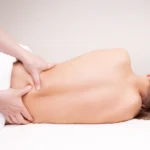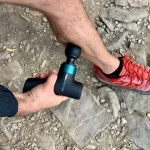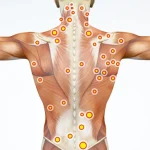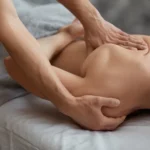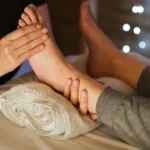If you’re dealing with the pain, tingling, or numbness of a pinched nerve, gentle massage may offer much-needed relief. When done correctly, massaging the affected area can help reduce inflammation, ease muscle tension, and improve circulation—supporting your body’s natural healing process. In this step-by-step guide, you’ll learn how to massage a pinched nerve safely and effectively, using techniques that can help relieve pressure and restore comfort.
Table of Contents
What is a Pinched Nerve?

A pinched nerve occurs when surrounding tissues—such as bones, muscles, or tendons—apply excessive pressure to a nerve, leading to irritation and discomfort. This compression can result from conditions like herniated discs, bone spurs, poor posture, or inflammation. One of the most common areas for a pinched nerve is the cervical spine (neck), which can radiate pain or numbness down the arms and into the hands.
🔎 Common Symptoms of a Pinched Nerve in the Neck:
- Persistent neck pain or stiffness
- Numbness or tingling in the arms or hands
- Muscle weakness or loss of grip strength
- Spasms in the neck or upper shoulders
- Tension headaches or migraines
If left untreated, a pinched nerve can lead to long-term nerve damage and chronic pain. That’s why early intervention is key. In many cases, massage therapy—when done properly—can help relieve nerve pressure, relax tight muscles, and promote healing without medication or invasive procedures.
🩺Causes of a Pinched Nerve

A pinched nerve occurs when surrounding tissues—such as muscles, bones, or tendons—apply too much pressure on a nerve, leading to pain, numbness, or tingling. Below are the most common causes:
🤕 Injury or Trauma
Sudden impact or trauma—like a bone fracture, dislocation, or whiplash—can compress a nerve directly. Injuries that lead to herniated discs or degenerative arthritis are also common contributors to pinched nerves, especially in the neck and spine.
💻 Repetitive Motion & Overuse
Repetitive activities, such as typing, using a computer mouse, lifting weights, or playing instruments, can cause swelling or inflammation around nerves. Over time, this can lead to compression injuries, especially in the wrist, elbow, or shoulder areas.
🧬 Tumors
Although less common, tumors in the spine or soft tissues can press against nearby nerves, disrupting function and causing symptoms of a pinched nerve.
🦠 Infections & Inflammation
Certain viral or bacterial infections can cause inflammation of spinal tissues, which may place pressure on adjacent nerves. Inflammatory conditions like rheumatoid arthritis may also contribute to nerve compression.
🎯 Pinched Nerve in the Shoulder: Specific Causes
Pinched nerves in the shoulder are often linked to repetitive strain or underlying structural issues in the neck and upper back:
- 🔁 Repetitive overhead movements (sports or job-related tasks)
- 💪 Rotator cuff injuries or shoulder impingement
- 🦴 Herniated cervical disc (in the neck) pressing on shoulder nerve roots
- 🧍 Scapular misalignment or postural imbalances
- 📦 Lifting heavy objects without proper form
These causes can lead to nerve compression either locally in the shoulder or from the neck (cervical radiculopathy), where nerves travel down the arm.
Symptoms of a Pinched Nerve
A pinched nerve occurs when surrounding tissues—such as bones, cartilage, muscles, or tendons—place excess pressure on a nerve. This compression disrupts the nerve’s normal function and can lead to a range of uncomfortable or even debilitating symptoms. The location and severity of compression will determine the exact symptoms experienced.
🔍 Common Signs of a Pinched Nerve:
- Tingling or burning sensation in the affected area (often described as “pins and needles”)
- Radiating pain that may travel along the nerve path (e.g. from neck to arm or back to leg)
- Numbness or reduced sensation, especially in hands, feet, or limbs
- Muscle weakness near the affected nerve, making it difficult to grip, lift, or move normally
- Difficulty moving the affected area due to stiffness or discomfort
- Sharp or shooting pain, especially during movement or when pressure is applied
Benefits of Massaging a Pinched Nerve

- Reduces Pain and Discomfort: Massaging the affected area can help reduce pain and discomfort due to a pinched nerve by increasing blood flow to the area. This can help to reduce inflammation and improve range of motion.
- Improves Mobility: Massaging the affected area can help improve mobility by increasing flexibility and strengthening muscles. This can help to reduce pain and improve function.
- Stimulates Healing: Massaging the affected area can stimulate healing by increasing the production of endorphins. Endorphins are natural hormones that help to reduce pain and promote relaxation.
- Reduces Stress: Massaging the affected area can help to reduce stress by promoting relaxation and reducing muscle tension. This can help to reduce pain and improve overall wellbeing.
🛠️ Preparation for Massaging a Pinched Nerve

Before you begin any massage for a pinched nerve—whether in the neck or shoulder—it’s important to create a calm, supportive environment and take the right precautions. Proper prep ensures you don’t worsen symptoms and helps maximize relief.
✅ 1. Consult a Medical Professional (If Needed)
If the person has severe symptoms (numbness, weakness, radiating pain), consult a doctor or physical therapist before attempting massage. Not all nerve compressions should be massaged—some may require rest, medication, or further diagnosis.
🧖♀️ 2. Choose a Comfortable Space
Set up in a quiet, low-stress area with soft lighting. Use a supportive chair, bed, or massage table where the neck and shoulders are easily accessible.
🔥 3. Apply a Warm Compress First
Place a heating pad or warm towel on the affected area for 5–10 minutes to increase circulation and relax tight muscles. This helps the body respond better to massage.
🧴 4. Use Massage Oil or Lotion (Optional)
To reduce friction and make movements smoother, you can use a small amount of massage oil or unscented lotion—especially around the shoulder or upper back.
👐 5. Wash and Warm Your Hands
Clean hands are essential to avoid irritation, especially if using oils. Rub your hands together for a few seconds to warm them before touching the skin.
🎯 6. Understand the Affected Area
Know where the nerve is likely compressed—whether it’s in the neck (cervical spine) or shoulder (brachial plexus area). This helps you target the correct muscles and avoid unnecessary pressure on sensitive areas.
Do You Need Different Massage Steps for Neck vs. Shoulder Pinched Nerves?
Yes—you do. Although both involve nerve compression, the location, underlying cause, and treatment approach differ between the neck and shoulder. That’s why using the same massage technique for both may not be effective—and could even make symptoms worse if done incorrectly.
A neck pinched nerve (typically cervical radiculopathy) often stems from spinal compression, such as a herniated disc or bone spur. This requires gentle massage, posture support, and care around the cervical spine. In contrast, shoulder-related nerve pain is usually caused by muscle tension, joint misalignment, or repetitive motion—making it more responsive to targeted, moderate-pressure massage.
🔍 Neck vs. Shoulder Pinched Nerve Massage: What’s Different?
| 🧠 Area | 🧍♂️ Neck (Cervical Spine) | 💪 Shoulder (Brachial Plexus/Rotator Cuff) |
|---|---|---|
| Common Causes | Herniated disc, bone spur, poor posture | Repetitive motion, rotator cuff strain, shoulder impingement |
| Symptoms | Neck pain, numbness in arms/hands, headaches | Shoulder pain, tingling down the arm, reduced range of motion |
| Massage Focus | Gentle release of neck muscles, posture support | Deep tissue work, shoulder mobility, trigger point release |
| Key Muscles Targeted | Upper trapezius, levator scapulae, suboccipitals | Deltoids, infraspinatus, pec minor, rhomboids |
| Pressure Level | Light to moderate (avoid spine) | Moderate to firm (as tolerated) |
| Safety Tips | Avoid direct pressure on the spine; consult a pro if symptoms worsen | Stay clear of inflammation; watch for referred pain or numbness |
Tailoring your massage approach to the location of the pinched nerve is essential for both safety and effectiveness. When in doubt, consult a licensed massage therapist or healthcare professional to avoid aggravating the condition.
How to Massage a Pinched Nerve (Safely & Effectively)
Massaging a pinched nerve in the neck or the shoulder can provide relief—but it’s important to proceed with care. The neck houses delicate structures, and too much pressure or incorrect technique may worsen symptoms. If you’re unsure or experiencing severe pain, consult a licensed massage therapist or healthcare professional before trying self-massage.
How to Massage a Pinched Nerve in the Neck
Always use light pressure and avoid pressing directly on the spine. If symptoms worsen, stop immediately and consult a healthcare provider.

Step-by-Step: Neck Pinched Nerve Relief
Step 1: Apply a Warm Compress
Place a warm towel or heating pad at the base of the neck for 5–10 minutes to relax tight muscles and boost circulation.
Step 2: Position Hands Correctly
Place your fingers on either side of the spine—never directly on it. Your hands should be aligned with the neck muscles.
Step 3: Begin Gentle Circular Motions
Use your fingertips to make small, circular movements at the base of the skull and along the sides of the neck. This eases tension in the suboccipitals and upper traps.
Step 4: Glide Down the Neck
Gently stroke downward from the skull to the shoulders in long, smooth motions to encourage lymphatic flow and relaxation.
Step 5: Target the Upper Trapezius
Apply light to moderate pressure to the upper shoulders, squeezing and kneading the trapezius muscles to reduce tension that may be pulling on the cervical spine.
Step 6: Finish with Light Strokes
End with a few soft strokes down the neck and shoulders to soothe the area and calm the nervous system.
💪 How to Massage a Pinched Nerve in the Shoulder
Shoulder massage can tolerate slightly deeper pressure, but avoid pressing into inflamed or extremely tender areas.

Step-by-Step: Shoulder Pinched Nerve Relief
Step 1: Warm the Area
Use a heating pad or warm compress on the shoulder and upper back to loosen the muscles before massage.
Step 2: Begin with Broad Strokes
Start by gliding your palm across the top of the shoulder and down the outer arm to assess tension and warm up the area.
Step 3: Use Circular Pressure on Tight Spots
Use your thumbs or fingers in small circular motions to target common tension zones: deltoid, infraspinatus (shoulder blade area), and pec minor (front shoulder/chest).
Step 4: Pin-and-Stretch
If tolerated, hold down a tight point in the muscle (like the back of the shoulder) while gently moving the arm in small circles. This improves mobility and releases tension.
Step 5: Massage Between the Shoulder Blades
Use your knuckles or massage ball to work the rhomboids and traps between the scapula and spine—great for posture-related compression.
Step 6: Stretch and Soothe
Gently stretch the arm across the chest and hold for 20–30 seconds. Finish with light strokes down the shoulder and upper arm.
💡 Pro Tips for Best Results
| 📝 Tip | 🔍 Why It Helps |
|---|---|
| Use a warm compress | Loosens tight muscles and boosts circulation before massage. |
| Take breaks | Prevents overstimulation and gives muscles time to relax and recover. |
| Don’t press too deep | Deep pressure can worsen nerve compression—stick to gentle, consistent strokes. |
| Stay hydrated | Drinking water post-massage helps flush out built-up tension and toxins. |
| See a doctor if pain persists | Ongoing symptoms may indicate a deeper issue requiring physical therapy or care. |
🌿 Self-Care Tips for a Pinched Nerve
Managing a pinched nerve at home involves a mix of rest, gentle movement, and targeted therapies. Here are some self-care strategies that can support healing and reduce discomfort:
🛏️ Rest
Give your body time to heal by avoiding activities that aggravate the nerve. Consider taking a break from work or strenuous tasks for a few days.
🧊 Ice Therapy
Apply an ice pack to the affected area for 15–20 minutes, 4–5 times a day. Ice helps reduce inflammation and provides temporary pain relief. Always use a cloth barrier to protect the skin.
🔥 Heat Therapy
After the initial inflammation subsides, use a warm compress or heating pad to relax tight muscles and improve circulation. Avoid heat if the skin is swollen, red, or inflamed.
🧘♂️ Gentle Stretching
Light stretching can relieve pressure on the nerve and improve flexibility. Start slow and avoid overstretching—listen to your body and stop if symptoms worsen.
🚶♀️ Low-Impact Exercise
Once acute pain decreases, engage in low-impact activities like walking, swimming, or yoga. These can strengthen surrounding muscles and support long-term recovery.
💆♀️ Massage
Gentle massage can help relax tight muscles and reduce nerve pressure. Focus on circular motions with light to moderate pressure for 5–10 minutes at a time.
💊 Medication
Over-the-counter options like ibuprofen or acetaminophen can reduce pain and inflammation. For more severe or persistent symptoms, a doctor may prescribe stronger medications.
🌱 Alternative Therapies
Treatments such as acupuncture, herbal remedies, or chiropractic adjustments may offer relief. Always consult a healthcare provider before starting any new therapy.
❓ Frequently Asked Questions
How do you release a pinched nerve?
Releasing a pinched nerve involves reducing pressure on the affected nerve through rest, posture correction, gentle massage, stretching, and sometimes physical therapy. Heat and ice therapy, along with low-impact exercises, can also help relieve compression. Severe or persistent cases may require medical treatment.
What type of massage is best for nerve pain?
Gentle techniques like myofascial release, Swedish massage, and trigger point therapy are often used for nerve pain. The goal is to reduce muscle tension and inflammation around the nerve without applying deep pressure that could worsen symptoms. Always consult a licensed therapist for guidance.
What should you not do with a pinched nerve?
Avoid heavy lifting, deep tissue massage, and high-impact exercises that may worsen compression. Don’t ignore symptoms like numbness or weakness, and avoid poor posture or repetitive motion that contributed to the issue. If pain worsens, stop all activity and seek medical advice.
What flares up a pinched nerve?
Common triggers include poor posture, overuse of muscles, prolonged sitting, stress, inflammation, and sleeping in an awkward position. Lifting heavy objects or sudden twisting movements can also aggravate the nerve. Identifying and avoiding these triggers is key to healing.
Can a pinched nerve in the back affect bowel movements?
In rare cases, yes. Severe compression of nerves in the lower spine (such as with cauda equina syndrome) can affect bladder and bowel control. This is a medical emergency. If you experience incontinence, numbness in the groin area, or loss of leg strength, seek immediate medical attention.
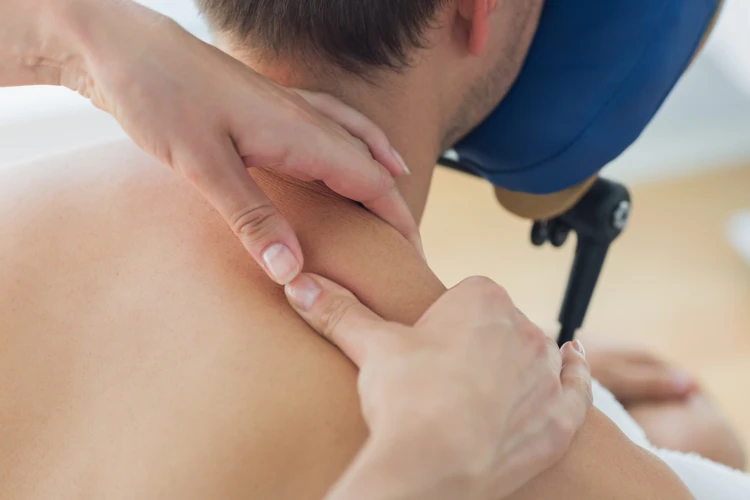
💗 Final Thoughts
Massage can be a safe, natural way to relieve a pinched nerve—but only when applied thoughtfully and in the right location. By following the right steps for either the neck or shoulder, you can ease pressure on the nerve, support healing, and reduce discomfort. Be patient with your body, go gently, and when in doubt, ask a professional for guidance.
Want more tips like this? Explore our full guide to natural pain relief, self-care routines, and recovery techniques!
📖 Also Read
👉 Unlock Relief From Neck Crunches With Massage Therapy
👉How to Use a Massage Ball for Sciatica Relief
👉Learn How to Ease Tennis Elbow Pain with Massage Therapy Techniques
📚References
🔗Pinched Nerve – Wikipedia
🔗Mayo Clinic – Pinched Nerve Symptoms and Causes
🔗Cleveland Clinic – Pinched Nerve Treatment
🔗Spine-health – Massage Therapy for Back and Neck Pain
⚠️ Disclaimer:
This article is for informational purposes only and does not constitute medical advice. Always consult with a licensed healthcare provider or certified massage therapist before beginning any new treatment, especially if you have pre-existing health conditions or concerns.


